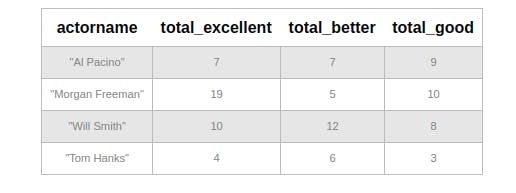From SQL to NoSQL world!
Part 1 of 2:
In this article, we will explore a developer's experience moving from writing SQL queries to NoSQL queries for analytics. We will divide this article into two parts. First part will cover SQL section.
PS: Readers should have in-depth knowledge on SQL and beginner knowledge on aggregation framework of MongoDB.
Let's take an example problem for understanding overall use case for this article.
Problem:
- We have two tables actor_survey for collecting information about how public rates actor based on their overall acting performance and actor_rating for different ratings used for defining their performance. We will use below MySQL queries to create tables.
-- actor_survey table
CREATE TABLE actor_survey
(
id INTEGER,
actor_name VARCHAR(100),
rating_id INTEGER
);
-- rating table
CREATE TABLE actor_rating
(
id INTEGER,
rating_name VARCHAR(100),
rating_description VARCHAR(100)
);
Note: Insert dummy data for testing.
For rating, we will use 3 levels:
- Excellent
- Better
- Good
Once we load data into the tables, we can start our journey of writing queries.
Let's start with getting aggregated data for excellent rating.
-- Aggregate query for excellent rating
SELECT actor_name AS actorName,
Count(acr.rating_name) AS total_excellent
FROM actor_survey acs
LEFT JOIN actor_rating acr
ON acs.rating_id = acr.id
WHERE rating_name = 'excellent'
GROUP BY actorName;
For getting aggregated data for better rating.
-- Aggregate query for better rating
SELECT actor_name AS actorName,
Count(acr.rating_name) AS total_better
FROM actor_survey acs
LEFT JOIN actor_rating acr
ON acs.rating_id = acr.id
WHERE rating_name = 'better'
GROUP BY actorName;
For getting aggregated data for good rating.
-- Aggregate query for good rating
SELECT actor_name AS actorName,
Count(acr.rating_name) AS total_good
FROM actor_survey acs
LEFT JOIN actor_rating acr
ON acs.rating_id = acr.id
WHERE rating_name = 'good'
GROUP BY actorName;
Now we can combine above sub queries and get overall aggregated data for our use case.
-- Total aggregated data for excellent, better and good rating
SELECT excellent.actorname,
excellent.total_excellent,
better.total_better,
good.total_good
FROM (SELECT actor_name AS actorName,
Count(acr.rating_name) AS total_excellent
FROM actor_survey acs
LEFT JOIN actor_rating acr
ON acs.rating_id = acr.id
WHERE rating_name = 'excellent'
GROUP BY actorName) AS excellent
RIGHT JOIN (SELECT actor_name AS actorName,
Count(acr.rating_name) AS total_better
FROM actor_survey acs
LEFT JOIN actor_rating acr
ON acs.rating_id = acr.id
WHERE rating_name = 'better'
GROUP BY actorName) AS better
ON better.actorName = excellent.actorName
RIGHT JOIN (SELECT actor_name AS actorName,
Count(acr.rating_name) AS total_good
FROM actor_survey acs
LEFT JOIN actor_rating acr
ON acs.rating_id = acr.id
WHERE rating_name = 'good'
GROUP BY actorName) AS good
ON good.actorName = better.actorName
Below is my expected output:

I hope this article would be useful for proceeding to next part. See you soon! If you have any comments, feedback then I would be happy to receive.